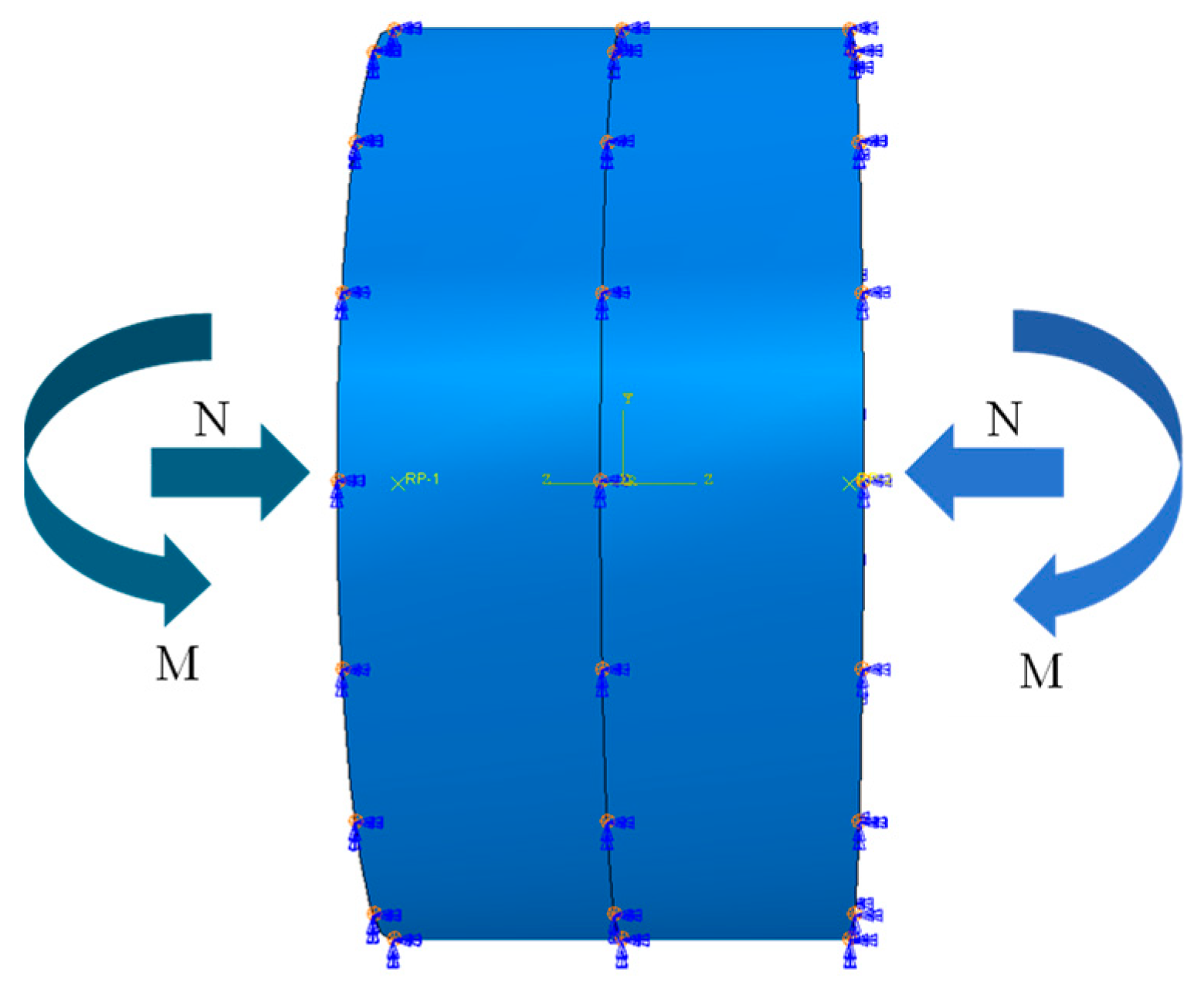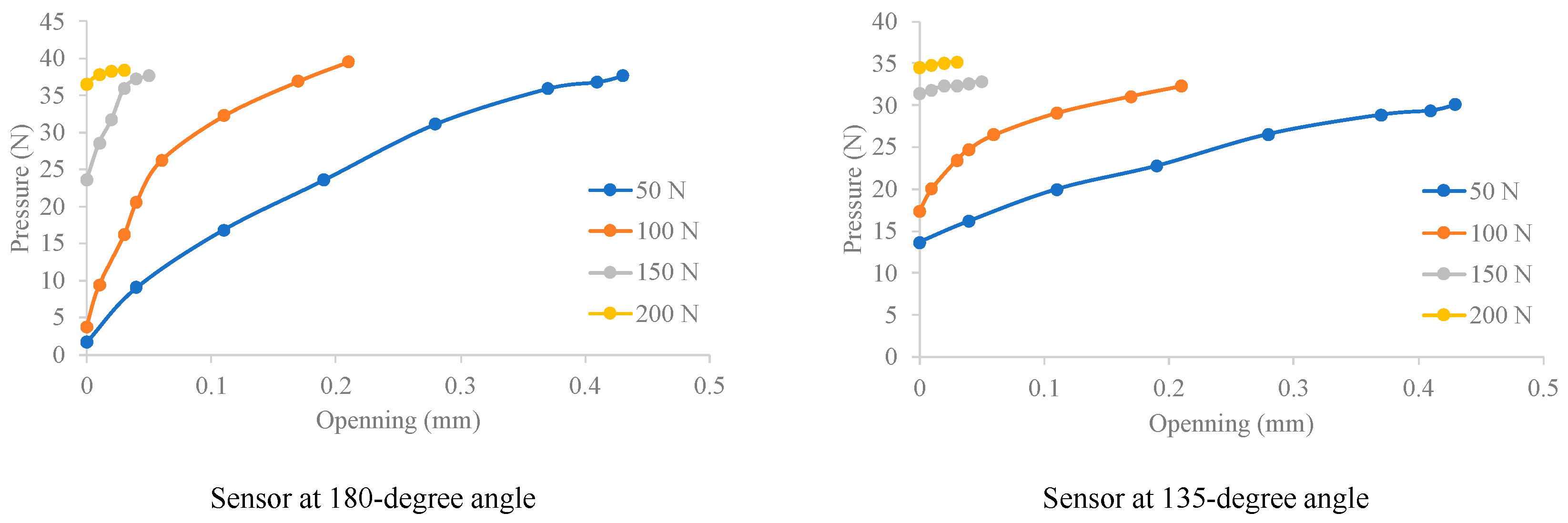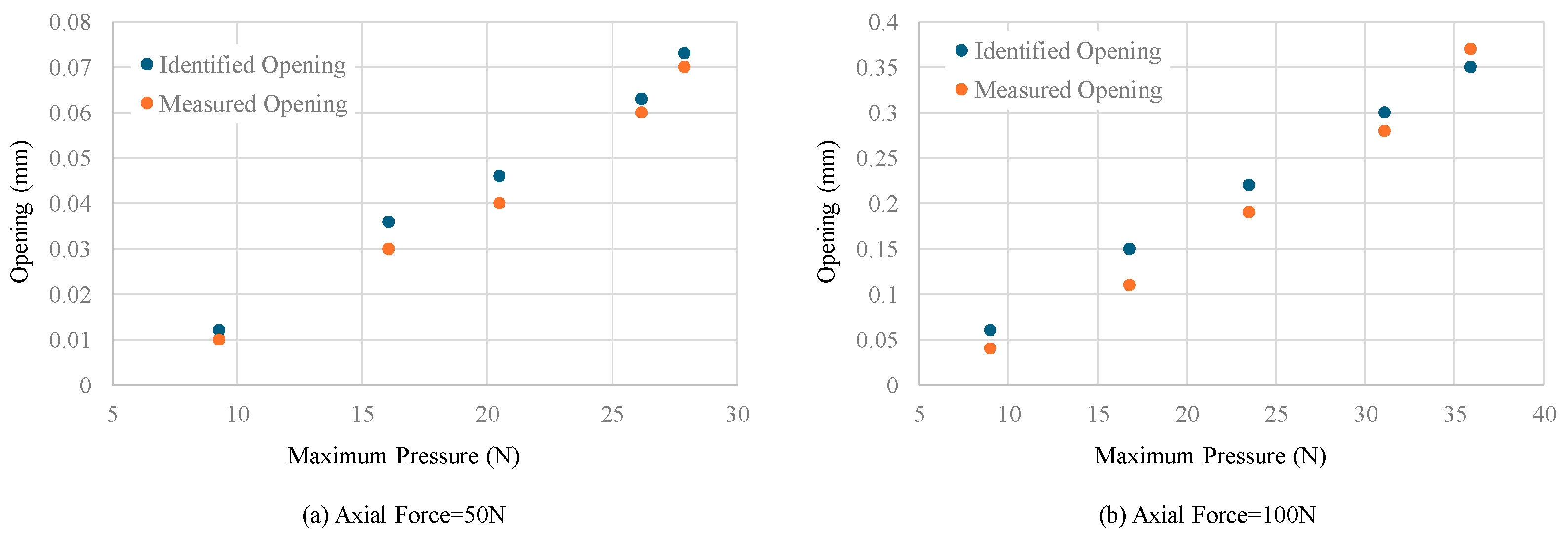Identification of Shield Tunnel Segment Joint Opening Based on Annular Seam Pressure Monitoring
Abstract
1. Introduction
2. Theoretical Analysis of the Correlation between Joint Opening and Seam Contact Pressure
3. Numerical Simulation
3.1. Engineering Case of a Cross-River Shield Tunnel for Modelling
3.2. Finite Element Model of Two Segments and Joints
3.3. Boundary Condition and Loading
3.4. Simulation Results and Comparison with Theoretical Analysis
4. Experimental Validation
4.1. Experimental Setup
4.1.1. Scaled Segment Model
4.1.2. Monitoring Sensor and Data Acquisition
- (1)
- Seam contact pressure sensor: Since the opening position is unpredictable in the 360-degree range, piezoelectric thin film pressure sensors are arranged at 45° intervals along the cross-section at the connection points of the model segment rings (as shown in Table 2). These sensors measure the contact pressure values and their changes at various measurement points when the tunnel undergoes different degrees of opening [30]. The sensor output signal wires are connected to a data acquisition device and accompanying equipment. The Dewesoft data acquisition device (Sirius-HD) is used to record and analyze data in real-time. The arrangement of the sensors is depicted in Figure 11.
- (2)
- Joint opening sensor: The middle part of the model tunnel, consisting of two segment rings, is selected as the subject of the experiment. Due to the bending deformation adopted in the experiment, which causes compression at the upper part of the segment rings and opening at the lower part, a stop block and a linear displacement sensor (referred to as LVDT, see Table 1) are fixed inside at the bottom of each segment. This setup ensures that when the segment rings are connected and closed, the stop block can push the rod back into the sensor to reset it, thereby measuring the opening amount of the annular seam. The opening condition is verified and data are recorded using an external digital display.
- (3)
- Axial force sensor: The magnitude of the longitudinal axial force applied to the segment model by the control baffle is monitored using ring-shaped force sensors placed at the bolt washers. The sensors are connected to a data acquisition device via signal wires to collect and record data in real time. The sensor setup is shown in Table 1 and Figure 11.
4.2. Loading Setup
4.3. Test Results
5. Joint Opening Identification Results and Discussion
6. Conclusions
- (1)
- Theoretical analysis: a beam-spring model was selected as the theoretical basis to establish the model for the opening segment rings. Considering actual engineering scenarios, the opening behavior between rings was categorized into three deformation modes, and the three possible stress states were analyzed. It was found that in the pure bending state, the position of the neutral axis on the contact surface remains constant. Analytical expressions were derived for the opening amount and maximum annular seam contact pressure under different axial forces and bending moments.
- (2)
- Numerical simulation: using ABAQUS 2022 software, the stress state of the segments during tunnel bending deformation was modeled and analyzed. A nonlinear relationship between the seam opening amount and longitudinal bending moment was obtained under constant axial force. Pressure at equidistant points on the seam contact surface was extracted, showing a decrease at all points except at the maximum contact pressure when the bending moment increased to a certain level due to the proximity of the neutral axis; only the maximum annular seam contact pressure maintained a monotonically increasing nonlinear relationship with the opening amount. The aforementioned results were compared with theoretical analyses, showing highly similar curve trends, thereby validating the correctness of the analytical derivation process and results and proving the feasibility of using multi-point pressure monitoring methods to identify segment opening.
- (3)
- Joint opening identification: a scaled model of the tunnel segments was designed and fabricated, and bending opening experiments were conducted by controlling the loading. Based on data collected from sensors, it was judged that the changes in seam contact pressure during opening were consistent with the finite element simulations, and the relationship curve between the maximum annular seam contact pressure and the opening amount also exhibited nonlinear characteristics. This further verified the correctness of the theoretical sections, including formula derivation and numerical simulations, from a practical perspective. Additionally, an opening amount identification method based on multi-point pressure data was proposed. The method has higher accuracy and sensitivity than using maximum annular seam contact pressure.
Author Contributions
Funding
Institutional Review Board Statement
Informed Consent Statement
Data Availability Statement
Acknowledgments
Conflicts of Interest
References
- Li, J. Development of Urban Rail Transit Construction Technology and Prospect. Urban Mass Transit 2018, 21, 76–79. [Google Scholar]
- Normile, D. Probe under Way after Japanese Tunnel Collapse Kills Nine. Engineering News-Record. 2012. Available online: https://www.enr.com/articles/5297-probe-under-way-after-japanese-tunnel-collapse-kills-nine (accessed on 5 March 2024).
- Liao, H. Analysis of a Soft Rock Subway Tunnel Collapse Accident and Optimization of Construction Safety Step. Master’s Thesis, South China University of Technology, Guangzhou, China, 25 April 2022. [Google Scholar]
- Ge, S.; Gao, W.; Wang, Y.; Xie, Y.; Chen, X.; Wang, S. Review on evaluation and treatment of traffic shield tunnel defects in China. China Civ. Eng. J. 2023, 56, 119–128. [Google Scholar]
- Li, G. Discussion on the Development Status and Trend of Shield Construction and Related Supporting Technology of Metro. Eng. Technol. Res. 2020, 5, 70–72. [Google Scholar]
- Wang, F.; Shi, J.; Huang, H.; Zhang, D.; Liu, D. A horizontal convergence monitoring method based on wireless tilt sensors for shield tunnels with straight joints. Struct. Infrastruct. Eng. 2021, 17, 1194–1209. [Google Scholar] [CrossRef]
- Yang, C.; Ouyang, H. A novel load-dependent sensor placement method for model updating based on time-dependent reliability optimization considering multi-source uncertainties. Mech. Syst. Signal Process. 2022, 165, 108386. [Google Scholar] [CrossRef]
- Yang, C. Interval strategy-based regularization approach for force reconstruction with multi-source uncertainties. Computer Methods Appl. Mech. Eng. 2023, 419, 116679. [Google Scholar] [CrossRef]
- Yang, C.; Liang, K.; Zhang, X.; Geng, X. Sensor placement algorithm for structural health monitoring with redundancy elimination model based on sub-clustering strategy. Mech. Syst. Signal Process. 2019, 124, 369–387. [Google Scholar] [CrossRef]
- Tan, X.; Chen, W.; Wu, G.; Wang, L.; Yang, J. A structural health monitoring system for data analysis of segment joint opening in an underwater shield tunnel. Struct. Health Monit. 2020, 19, 1032–1050. [Google Scholar] [CrossRef]
- Liu, X.; Zhang, J.; Jiang, Z.; Liu, Z.; Xu, P.; Li, F. Experimental Investigations of a Segmental Tunnel Ring Strengthened by Using UHPC. China J. Highw. Transp. 2021, 34, 181–190. [Google Scholar]
- Zhang, J.; Zhao, M. Monitoring System for Circular Deformation in Metro Shield Tunnels in Soft Soils. Adv. Civ. Eng. 2020, 2020, 8886402. [Google Scholar] [CrossRef]
- Atsushi, K.; Hirotomo, M.; Kenso, N. Study on the Analytical Model of Shield Tunnel in Longitudinal Direction. Jpn. J. JSCE 1988, 1988, 79–88. [Google Scholar]
- Yukio, S.; Kazuhiko, K.; Naomi, O.; Takashi, K. An Evaluation Method of Longitudinal Stiffness of Shield Tunnellinings for Application to Seismic Response Analyses. Jpn. J. JSCE 1988, 1988, 319–327. [Google Scholar]
- Liang, R.; Zhang, Z.; Li, Z.; Fu, Y.; Cao, S.; Kang, C.; Xiao, M. Simplified solutions for longitudinal deformation of shield tunnels considering influences of circumferential joints. Chin. J. Geotech. Eng. 2024, 46, 254–263. [Google Scholar]
- Zhang, W.; Xu, X.; Li, X.; Shen, Y.; Zhang, M. Research on Generalized Longitudinal Equivalent Continuous Model of Shield Tunnels. Chin. J. Rock Mech. Eng. 2009, 28, 3938–3944. [Google Scholar]
- Jiang, J.; Lu, C.; Shen, L. Research on longitudinal nonlinear seismic response of shield tunnel. J. Hydroelectr. Eng. 2005, 24, 10–15. [Google Scholar]
- Wu, H.-N.; Shen, S.-L.; Liao, S.-M.; Yin, Z.-Y. Longitudinal structural modelling of shield tunnels considering shearing dislocation between segmental rings. Tunn. Undergr. Space Technol. 2015, 50, 317–323. [Google Scholar] [CrossRef]
- Yang, C.; Fan, Z.; Xia, Y. Convex Model-Based Reduced-Order Model for Uncertain Control Systems. IEEE Trans. Syst. Man Cybern. Syst. 2024, 1–11. [Google Scholar] [CrossRef]
- Yang, C.; Fan, Z.; Lu, W.; Gao, H. Uncertain Iterative Optimal Attitude Control Method for Periodic Satellite With Reliability Constraint. IEEE Trans. Aerosp. Electron. Syst. 2024, 1–15. [Google Scholar] [CrossRef]
- Geng, P.; Chen, P.; Zhang, J.; He, C.; Yan, Q. Nonlinear longitudinal equivalent bending stiffness of shield tunnel under the combined effect of axial force and bending moment. Chin. J. Rock Mech. Eng. 2017, 36, 2522–2534. [Google Scholar]
- Wang, Z.; Shi, C.; Gong, C.; Cao, C.; Peng, Z.; Sun, Y. Calculation model of longitudinal nonlinear equivalent bending stiffness of shield tunnel considering its transverse performance. Rock Soil Mech. 2023, 44, 1295–1308. [Google Scholar]
- Zhang, H.; Fu, D.; Guo, C. Present status and development of segment design for the shield driven running tunnel of metro. Mod. Tunn. Technol. 2002, 39, 28–33+41. [Google Scholar]
- Zeng, D.; He, C. Study on Factors Influential in Metro Shield Tunnel Segment Joint Bending Stiffness. J. China Rail Way Soc. 2005, 27, 90–95. [Google Scholar]
- Zeng, D.; He, C. Numerical Simulation of Segment Joint Bending Stiffness of Metro Shield Tunnel. J. Southwest Jiaotong Univ. 2004, 39, 744–748. [Google Scholar]
- Zhang, J. Study on Calculations and Influence Factors of Bending Stiffness of Segment Ring Joints of Shield Tunnels. Modern Tunn. Technol. 2020, 57, 104–112. [Google Scholar]
- Zhang, J.; He, C.; Geng, P.; Chen, P.; Lu, Z. Study on Bending State Nonlinearity of Shield-Tunnel Ring Joints. Eng. Mech. 2018, 35, 35–44. [Google Scholar]
- Zhang, Z.; Liang, R.; Li, Z.; Kang, C.; El Naggar, M.; Xiao, M.; Wu, W. Analytical solution for longitudinal deformation of shield tunnel induced by overcrossing tunnelling considering circumferential joints. J. Rock Mech. Geotech. Eng. 2023, 15, 2355–2374. [Google Scholar] [CrossRef]
- Zhang, Y.; Huang, H.; Zhang, D.; Ayyub, B.M. Deformation recoverability of longitudinal joints in segmental tunnel linings: An experimental study. Tunn. Undergr. Space Technol. 2022, 124, 104475. [Google Scholar] [CrossRef]
- Jiao, T.; Zhou, Z. An optical-electrical co-sensing tape for cross-sectional deformation monitoring of shield tunnels. Tunn. Undergr. Space Technol. 2021, 117, 104148. [Google Scholar] [CrossRef]















| Structural Part | Material | Element Type | Dimension | Property |
|---|---|---|---|---|
| Segment ring | C50 Concrete | C3D8R | Outer 6 m Inner 5.3 m Length 1.5m | Modulus 34.5 GPa Poisson’s ratio 0.2 |
| Joint bolt | Grade 8.8 Steel | B31 | M30 | Modulus 205 GPa Poisson’s ratio 0.3 |
| Monitoring Parameter | Sensor | Sensor Picture |
|---|---|---|
| Seam contact pressure | Thin film pressure sensor |  |
| Joint opening | LVDT |  |
| Axial force | Load cell |  |
Disclaimer/Publisher’s Note: The statements, opinions and data contained in all publications are solely those of the individual author(s) and contributor(s) and not of MDPI and/or the editor(s). MDPI and/or the editor(s) disclaim responsibility for any injury to people or property resulting from any ideas, methods, instructions or products referred to in the content. |
© 2024 by the authors. Licensee MDPI, Basel, Switzerland. This article is an open access article distributed under the terms and conditions of the Creative Commons Attribution (CC BY) license (https://creativecommons.org/licenses/by/4.0/).
Share and Cite
Xu, H.; Liu, Q.; Li, B.; Guo, C. Identification of Shield Tunnel Segment Joint Opening Based on Annular Seam Pressure Monitoring. Sensors 2024, 24, 3924. https://doi.org/10.3390/s24123924
Xu H, Liu Q, Li B, Guo C. Identification of Shield Tunnel Segment Joint Opening Based on Annular Seam Pressure Monitoring. Sensors. 2024; 24(12):3924. https://doi.org/10.3390/s24123924
Chicago/Turabian StyleXu, Hongbin, Qucheng Liu, Bingtian Li, and Chuanrui Guo. 2024. "Identification of Shield Tunnel Segment Joint Opening Based on Annular Seam Pressure Monitoring" Sensors 24, no. 12: 3924. https://doi.org/10.3390/s24123924
APA StyleXu, H., Liu, Q., Li, B., & Guo, C. (2024). Identification of Shield Tunnel Segment Joint Opening Based on Annular Seam Pressure Monitoring. Sensors, 24(12), 3924. https://doi.org/10.3390/s24123924







